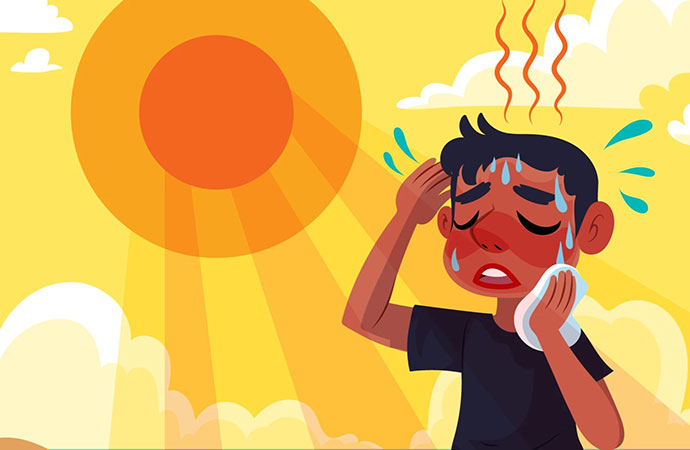Reportage

Freepik
The scorching heat waves can pose serious health risks, especially for people who stay outdoors for long hours due to occupation. During hot weather situations in summer, people working under the sun may suffer from heat-related illnesses like dehydration, heatstroke, etc. Let's explore some effective tips to safeguard outdoor workers from the debilitating effects of heat waves.
What is Heatstroke?
Heat stroke is a severe heat-related illness characterised by a body temperature of 104°F (40°C) or higher. It arises when your body overheats and the body's internal temperature regulation system fails, typically due to prolonged exposure to high temperatures or strenuous physical activity and dehydration. It is most prevalent during the summer season.
Immediate medical attention is necessary for heatstroke. If left untreated, it can swiftly lead to damage to vital organs such as the brain, heart, kidneys, and muscles. Delaying treatment exacerbates the damage, heightening the risk of severe complications or even death.
Symptoms of Heat Stroke
The most common symptoms of heatstroke include:
- High body temperature (above 104°F or 40°C)
- Altered mental state, such as confusion or disorientation
- Nausea and vomiting
- Flushed or red skin
- Rapid breathing
- Rapid heartbeat.
Summer Tips for Outdoor Workers to Prevent Heat Stroke
Hydrate Regularly
It is important to make sure to stay hydrated by drinking plenty of fluids throughout the day, even if you do not feel thirsty. It is crucial to prevent dehydration, which can increase the risk of heat-related illnesses.
Aim to drink around 500 ml of water before starting your work, and then aim for 150 to 200 ml every 15-20 minutes, especially when working in hot and humid conditions. It would be helpful to carry a refillable water bottle with you and take frequent sips throughout the day to maintain hydration levels.
Avoid Dehydrating Drinks
It is highly recommended to avoid caffeinated beverages like coffee, tea, and soft drinks, as these products can worsen dehydration. Similarly, sugary drinks should be avoided. Instead, replenish lost electrolytes by opting for sports drinks or electrolyte tablets, especially if you are sweating profusely. These options can help maintain hydration levels and support your body's needs during hot weather conditions.
Schedule Breaks
Try to take breaks in shaded or cool spots to rest and cool down. One should refrain from working during the peak heat hours. Seek shade or air-conditioned areas for frequent breaks. Additionally, schedule physically demanding tasks for cooler periods like early mornings or evenings.
One can use cooling methods such as misting fans or cooling towels to lower one's body temperature. Prioritising these measures helps prevent overheating and maintains productivity in hot weather conditions.
Dress Appropriately
It is necessary to dress appropriately for hot weather by wearing loose-fitting, lightweight clothing in light colours, ideally made from breathable materials like cotton. Steer clear of dark-coloured clothing, which absorbs heat.
You should also protect yourself further by wearing a wide-brimmed hat to shield your head and face from the sun, and donning sunglasses to safeguard your eyes from harmful UV rays. These measures help you stay cool and comfortable while working outdoors in the heat.
Use Sunscreen
Using sunscreen is one of the most important things in summer. Prepare in advance and shield yourself from the sun by applying sunscreen with an SPF of 30 or above to exposed skin. Ensure to apply it at least 20 minutes before going outdoors and reapply every two hours, or more frequently if sweating or swimming.
This precautionary measure helps prevent sunburn, which can hinder your body's ability to regulate temperature effectively. This will keep you safe and comfortable in the heat.
Know the Signs
It is essential to be aware of the signs of heat stroke, such as high body temperature, confusion, nausea, and rapid heartbeat. Additionally, monitor your urine output as dark-coloured urine indicates dehydration.
If your urine appears dark, it is crucial to increase your fluid intake to prevent dehydration and reduce the risk of heat-related illnesses. Stay vigilant and take prompt action to safeguard your health in hot weather conditions.
Stay Indoors During Peak Hours
Where feasible, it is better to refrain from outdoor activities during the peak heat hours, usually between 10 am and 4 pm. Stay informed about the heat index, which considers both temperature and humidity levels to gauge how hot it feels.
A higher heat index indicates an increased risk of heat-related illnesses. By being mindful of these factors, you can better protect yourself from the adverse effects of hot weather conditions.
Eat Light Meals
It is essential to opt for light, easily digestible meals to prevent exerting additional strain on your body in hot weather. Incorporate fibre-rich fruits and natural juices into your diet while avoiding high-protein foods.
You need to prioritise foods that aid hydration and provide energy, such as fruits, vegetables, and whole grains. Try to avoid heavy meals that may leave you feeling lethargic, ensuring you stay nourished and refreshed in warm conditions.
Acclimatise
Experts suggest gradually acclimating to hot weather by increasing outdoor activity levels over several days. This gradual adjustment allows your body to adapt to working in the heat more effectively and reduces the risk of heat-related issues.
Monitor Co-workers
It is vital to support your colleagues by monitoring their well-being and prompting them to take regular breaks and maintain hydration. Try to be vigilant for signs of heat stroke, including headaches, dizziness, nausea, vomiting, confusion, and slurred speech.
Also, encourage prompt medical attention if these symptoms arise. If you or a co-worker experience symptoms of heat stroke, seek medical assistance immediately. Heat stroke necessitates immediate medical attention.
Final Words
During the summer heat waves, many people work in the sun due to their occupational needs. Protecting outdoor workers from heatstroke requires a multifaceted approach that addresses both preventive measures and emergency response protocols.
By implementing these tips and raising awareness about heat-related risks, employers can safeguard the health and well-being of their workforce, even in challenging climates like heat waves in Bangladesh.

























Leave a Comment
Recent Posts
Rescheduling classified loans ...
Inflation has remained stubborn for months and cannot be curbed becaus ...
The issue of school closures a ...
The showers over different parts of Dhaka on Thursday night came as we ...
Bangladesh has slipped two notches on the World Pres ..
Seeking solace in ‘Stiched Collage’: The artistic jo ..
An EU official in Georgia has said that the country’ ..
ADB stresses need for better resource allocation for ..